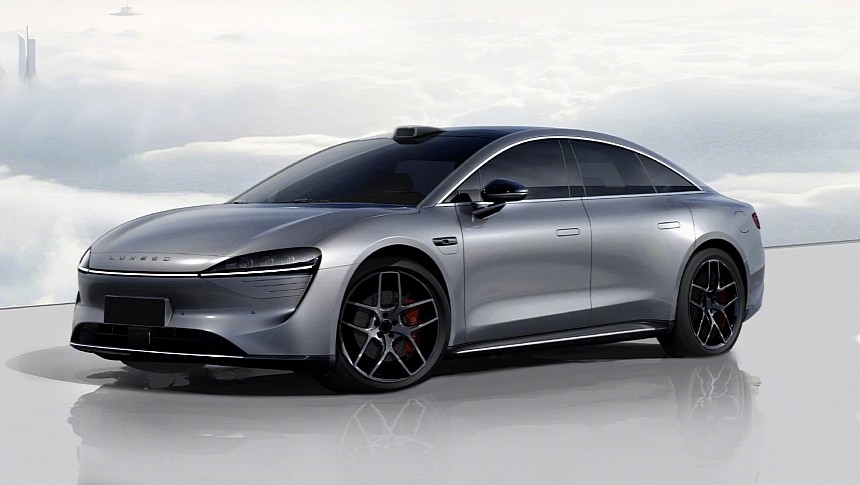Huawei has just launched the Luxeed S7 in China. The electric sedan comes to rival the Tesla Model S, not the Model 3, as originally thought, before the brand released info about its size, tech, and performance.
Luxeed is Huawei’s second car brand after Aito, which already launched several models. The Luxeed S7 boasts a very low energy consumption of only 12.4 kWh/100 km (62 miles). Sporting an 800 V architecture, it can charge in 15 minutes, which is enough for 430 kilometers (267 miles).
Equipped with Huawei's ADS 2.0 self-driving package, the Luxeed S7 is capable of parking itself. It is packed with sensors, one LiDAR sensor included, with three-millimeter wave radars, 12 ultrasonic radars, and 11 high-definition cameras.
The model is also equipped with the HarmonyOS 4 system, which is compatible with Huawei phones, laptops, and smartwatches, supporting video games thanks to the 8295 chip from Qualcomm.
The Tesla FSD-like driving software Navigation Cruise Assist (NCA) will be available in China before the end of the year. Furthermore, Huawei will get the Parking Valet function running in seven major cities across the country in early 2024.
The model measures 188.6 inches (4,971 millimeters) in length, 77.3 inches (1,963 millimeters) in width, and (58 inches) 1,474 millimeters in height, sporting a wheelbase of 116.1 inches (2,950 millimeters). The drag coefficient is of only 0.20, beating the Tesla Model S in this department.
The top-of-the-line Luxeed S7 is powered by two electric motors, one mounted on the front axle and the other one in the rear, for a combined output of 489 horsepower (496 PS). It can do the 0 to 62 mph (0-100 kph) run in 3.3 seconds.
Depending on the trim, the car comes equipped with a 62-, 82-, or 100-kWh battery pack. The latter provides 531 miles (855 kilometers) of range in the generous CLTC testing procedure. The battery charges enough for 215 kilometers in five minutes, Huawei says.
The car will enter production before the end of the year and will be manufactured by Huawei’s joint partner Chery Auto, which is also the supplier of the E0X platform the car is built on. The model has a starting price of 249,800 yuan, the equivalent of $35,269 at the current exchange rates. This is the price of the entry-level Pro trim. At the opposite end, there is the Max RS, which starts at 349,800 yuan ($49,391).
The Tesla Model S rival has been available for pre-order since November 9. Over 20,000 customers reserved a car in less than three weeks. For those who place the order before December 31, Huawei has 55,000 yuan ($7,766) worth of benefits.
In 2024, the tech giant is planning to build over 100,000 600 kW superchargers in China.
Equipped with Huawei's ADS 2.0 self-driving package, the Luxeed S7 is capable of parking itself. It is packed with sensors, one LiDAR sensor included, with three-millimeter wave radars, 12 ultrasonic radars, and 11 high-definition cameras.
The model is also equipped with the HarmonyOS 4 system, which is compatible with Huawei phones, laptops, and smartwatches, supporting video games thanks to the 8295 chip from Qualcomm.
The Tesla FSD-like driving software Navigation Cruise Assist (NCA) will be available in China before the end of the year. Furthermore, Huawei will get the Parking Valet function running in seven major cities across the country in early 2024.
The model measures 188.6 inches (4,971 millimeters) in length, 77.3 inches (1,963 millimeters) in width, and (58 inches) 1,474 millimeters in height, sporting a wheelbase of 116.1 inches (2,950 millimeters). The drag coefficient is of only 0.20, beating the Tesla Model S in this department.
The top-of-the-line Luxeed S7 is powered by two electric motors, one mounted on the front axle and the other one in the rear, for a combined output of 489 horsepower (496 PS). It can do the 0 to 62 mph (0-100 kph) run in 3.3 seconds.
Depending on the trim, the car comes equipped with a 62-, 82-, or 100-kWh battery pack. The latter provides 531 miles (855 kilometers) of range in the generous CLTC testing procedure. The battery charges enough for 215 kilometers in five minutes, Huawei says.
The car will enter production before the end of the year and will be manufactured by Huawei’s joint partner Chery Auto, which is also the supplier of the E0X platform the car is built on. The model has a starting price of 249,800 yuan, the equivalent of $35,269 at the current exchange rates. This is the price of the entry-level Pro trim. At the opposite end, there is the Max RS, which starts at 349,800 yuan ($49,391).
The Tesla Model S rival has been available for pre-order since November 9. Over 20,000 customers reserved a car in less than three weeks. For those who place the order before December 31, Huawei has 55,000 yuan ($7,766) worth of benefits.
In 2024, the tech giant is planning to build over 100,000 600 kW superchargers in China.







